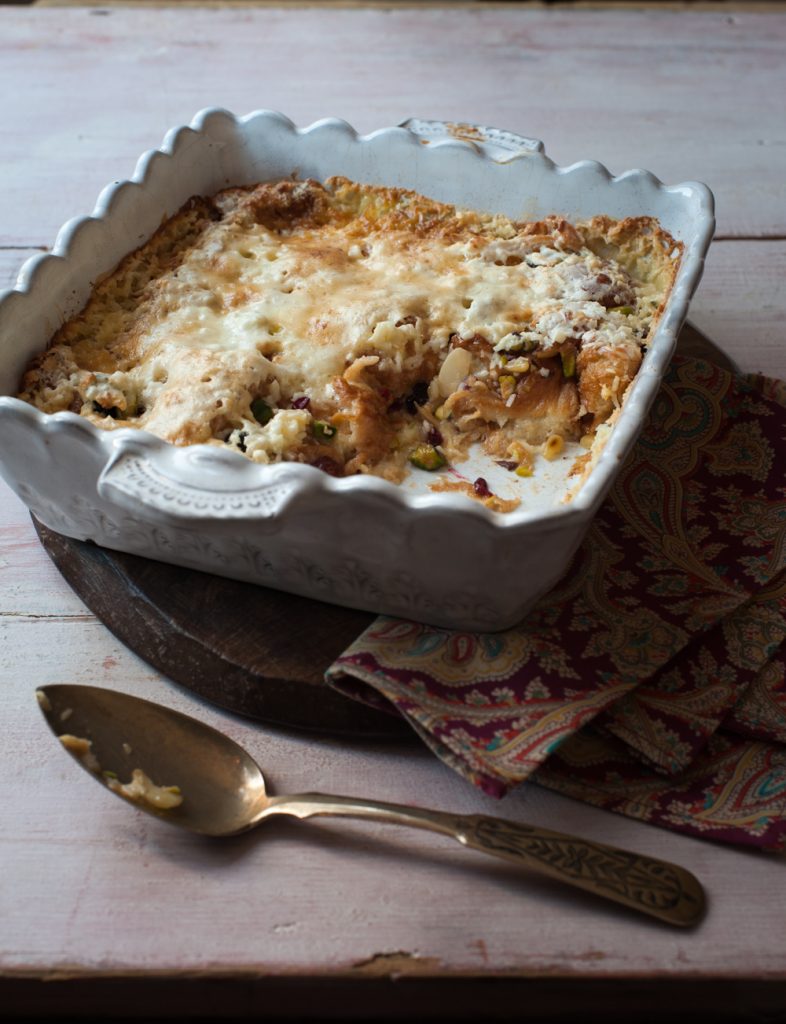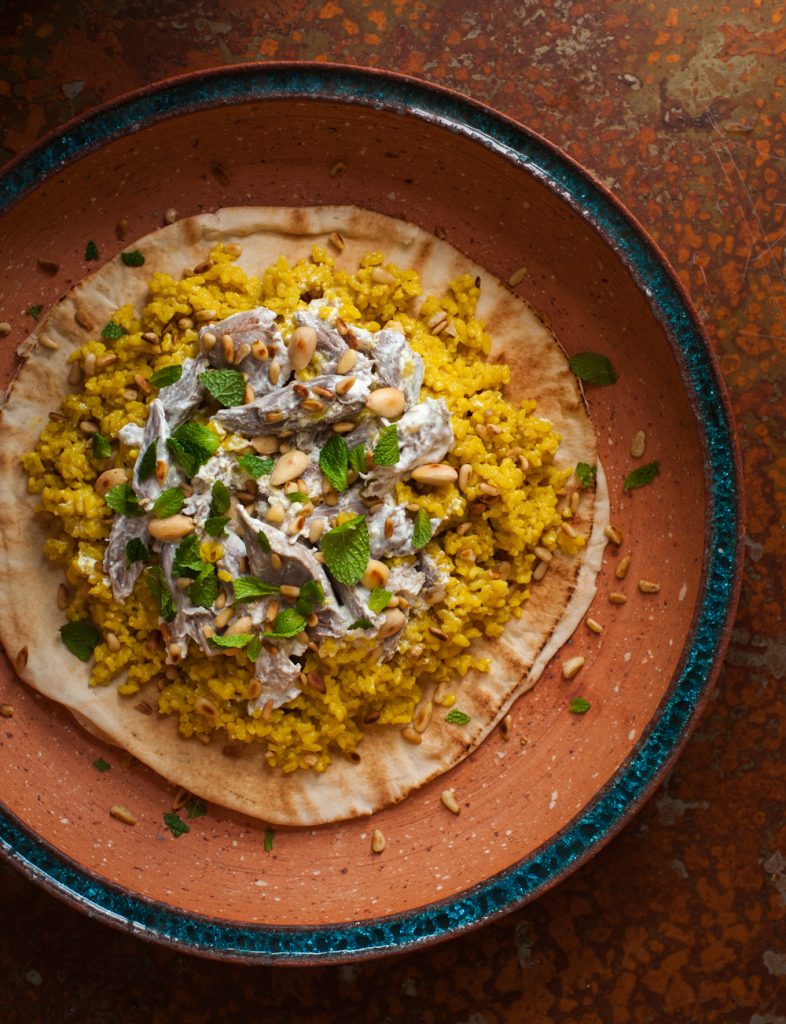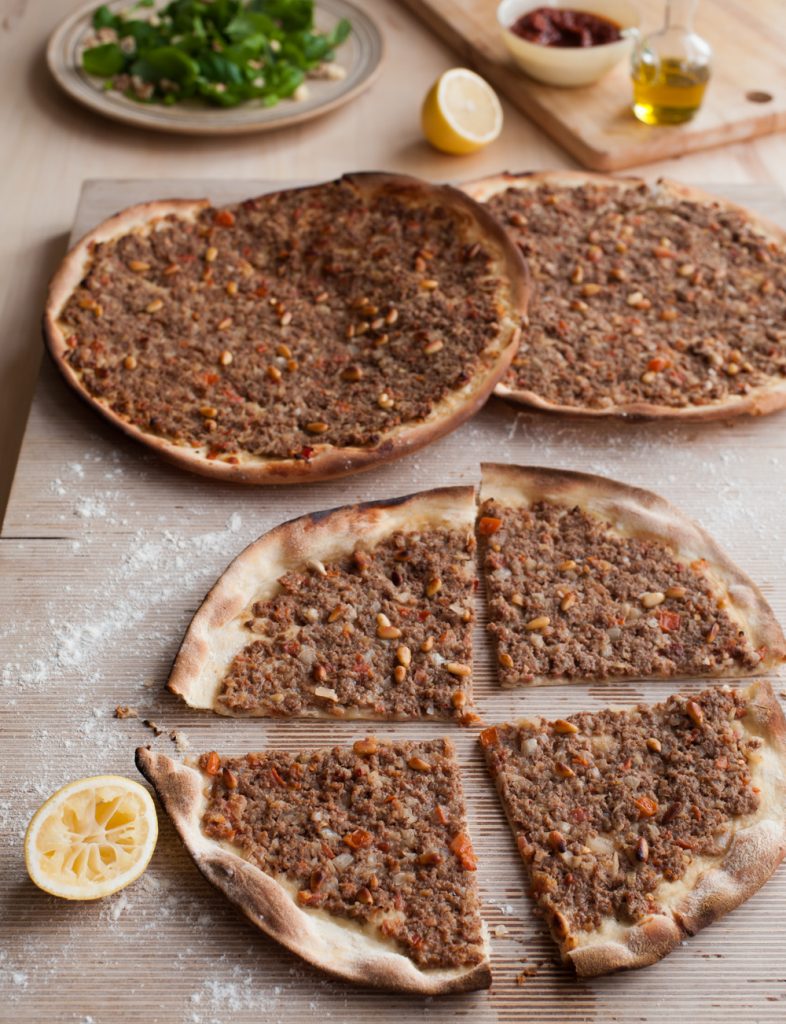In this culinary journey across the Middle East celebrated author and TV chef Bethany Kehdy takes us to Egypt, Jordan and her home country, Lebanon. Known for bringing together her childhood memories of traditional Middle Eastern cuisine and realising them in a fresh, modern manner, Kehdy shares her take on three Middle Eastern favourites taken straight from her forthcoming cookbook, The Jewelled Kitchen.
This dessert, also known as Um Ali Bread Pudding is a mouth-watering way to use up stale croissants – or a great reason to go and buy some!
Bethany Kehdy
Egyptian Spiced Bread Pudding
This dessert, also known as Um Ali Bread Pudding, is named after the Egyptian mother, Um Ali. It’s also a mouth-watering way to use up stale croissants – or a great reason to go and buy some!
Serves 4
Preparation time: 15 minutes Cooking time: 30 minutes
Ingredients
4 all-butter croissants
2 tbsp raisins or dried mixed berries
2 tbsp flaked almonds, plus extra to sprinkle
2 tbsp pine nuts, plus extra for sprinkling
2 tbsp roughly chopped shelled pistachios
250ml/9 oz/1 cup milk
5 tbsp caster sugar
1⁄4 tsp ground cinnamon
2 tsp orange blossom water
250ml/9 oz/1 cup whipping cream
4 tbsp desiccated coconut
1 small egg, beaten
1 Preheat the oven to 180 ̊C/350 ̊F/Gas 4 and line a baking sheet with parchment paper.
2 Tear up the croissants into bite-size pieces, place on the baking sheet and bake in the oven for 10 minutes until crisp and golden.
3 Spread the baked croissant pieces across the base of a baking dish, about 28cm/111⁄4in square. Sprinkle over the raisins, almonds, pine nuts and pistachios, making sure they are spread evenly.
4 Heat the milk in a heavy-based saucepan over a medium heat, add 3 tablespoons of the sugar and mix well to dissolve. Reduce the heat to low, add the cinnamon and orange blossom water and heat through at a gentle simmer for 3–4 minutes. Remove the pan from the heat and leave it to cool so that the egg will not scramble when it’s added to it.
5 Meanwhile, put the cream and the remaining sugar in a mixing bowl and whisk until the mixture forms soft peaks. Sprinkle in the coconut and gently fold to incorporate.
6 Add the egg to the cool milk mixture and whisk to combine. Ladle the mixture into the baking dish and spread the whipped cream over the top.
7 Bake in the oven for 15 minutes until everything is bubbling and the top is golden, if necessary placing it under a hot grill for the last 1–2 minutes to brown the top. Remove from the oven and leave to stand for a couple of minutes.
Serve warm.
Anwaar Younis gave me her recipe for Jordan’s national dish.
Bethany Kehdy
Auntie Anwaar’s Mansaf Risotto
Traditionally, this quintessentially Bedouin dish is prepared using jameed, which is a dried yogurt or buttermilk sometimes called rock cheese. Anwaar Younis gave me her recipe for Jordan’s national dish, which I’ve tweaked a little. Mansaf is a communal dish and a great symbol of generosity that is often served on special occasions. Sometimes eaten with the right hand, the meat is torn apart and rolled into a ball, which is then dipped into the yogurt. Jameed is not easy to source in the West, so I have used Greek yogurt instead.
Serves 4
Preparation time: 15 minutes
Plus making the bread cooking time: 1 1⁄2 hours
Ingredients
30g/1oz salted butter
850g/1lb 14oz lamb shank(s)
2 carrots roughly chopped
1 onion, quartered
10 garlic cloves, 5 left whole and 5 pounded using a pestle and mortar or crushed
6 cardamom pods
1 bay leaf
1 cinnamon stick
200g/7oz/scant 1 cup short-grain or risotto rice
1 tsp turmeric
750ml/26 oz/3 cups Greek yogurt
1 egg
1 tbsp corn flour, if needed
3 tbsp pine nuts
3 tbsp blanched almonds
juice of 2 lemons
2 loaves of warm Arabic Bread*
Mint leaves, finely chopped, to sprinkle
Sea salt and freshly ground black pepper
1 Melt the butter in a heavy-based saucepan over a medium heat, add the lamb shank(s), carrots, onion, whole garlic cloves, cardamom pods, bay leaf and cinnamon stick and cook for 4–5 minutes, turning frequently, until the meat has browned. Season with salt to taste, then cover with 1.25l/44 oz/5 cups water and bring to the boil. Reduce
the heat to low, then cover and simmer for 1 hour or until the meat is tender and falling off the bone. Strain well, reserving the stock and the meat, but discarding the vegetables and spices.
2 Put the rice, 750ml/26 oz/3 cups of the reserved stock and the turmeric in a separate heavy-based pan over a medium heat. Bring to the boil, then reduce the heat to low and simmer for 25 minutes or until the rice is cooked through and all the stock has been absorbed, adding a little more stock as needed and stirring every so often to achieve a creamy texture. Season to taste with salt and pepper.
3 Meanwhile, separate the meat from the bone, cut into smaller pieces and set aside. Put the yogurt in the pan the meat was cooked in and place over a medium heat, then add the egg and whisk well. Return the meat to the pan and bring the mixture to a gentle boil. Reduce the heat to low and simmer, stirring often so that the yogurt doesn’t catch, for 15–20 minutes until the yogurt is thick and creamy. If the mixture is too runny, add the corn our and mix until thickened.
4 Toast the pine nuts and almonds in a heavy-based pan over a medium heat for 1–2 minutes until golden, shaking the pan often.
5 Put the crushed garlic in a small bowl, add the lemon juice and mix. To serve, lay out the Arabic Bread on a large serving platter and pour the garlic mixture over it. Spoon over the rice, then spoon over a couple of tablespoons of the lamb and yogurt mixture. Scatter with the meat pieces and then sprinkle over the toasted nuts and mint. Serve the remaining cooked yogurt on the side.
Although these are known by Armenians as missahatz, by Turks as lahmacun and by the Lebanese as lahm b’ajeen, the basic idea is the same: spread meat on bread.
Bethany Kehdy
Spiced Lamb Flatbread pizzas
Although these are known by Armenians as missahatz, by Turks as lahmacun and by the Lebanese as lahm b’ajeen, the basic idea is the same: spread meat on bread. The best flatbread pizza I’ve ever had, second to this recipe of course, was at an Armenian bakery called Furn Ikhshanian, in Zokak el Blat, a district of Beirut. The reason for this was their paper-thin and crispy dough. Flatbread pizzas belong to the manaquiche family, and while manaquiche is considered a breakfast food, they can be enjoyed throughout the day!
They’re best when washed down with a savory yogurt shake.
Serves 4
Preparation time: 25 minutes,
Plus making the dough and rising time
Cooking time: 5–7 minutes
2 large onions, very finely chopped
4 large plum tomatoes, very finely chopped
1 tsp sea salt
400g/14oz finely minced lamb
1 tsp ground cinnamon
1 tsp ground allspice
1 tsp hot chilli flakes
2 tbsp pomegranate molasses
1 recipe quantity Arabic Bread dough*
Flour, for dusting
3 tbsp pine nuts
1 Put the onions and tomatoes in a bowl. Note that they must be chopped almost to a paste. Sprinkle the paste with the salt and set aside for 5 minutes, then squeeze out as much liquid as possible.
2 Put the well-squeezed tomatoes and onions in a bowl with the lamb, sprinkle with the cinnamon, allspice and chilli flakes and drizzle with the pomegranate molasses, then mix well.
3 Preheat the oven to 250 ̊C/500 ̊F/Gas 9. Divide the bread dough into 4 balls of equal size (about 125g/41⁄2oz each) and dust the work surface with our. Roll out each ball to about 30cm/12in in diameter (the dough should be paper thin). Using your fingers, gently spread one-quarter of the meat mixture evenly and thinly across each piece of dough. Sprinkle the pine nuts over the pizzas.
4 Transfer the pizzas to perforated round pizza crispers and bake in the oven for 5–7 minutes until the edges of the pizzas are golden and crispy. Alternatively, use baking sheets to slide the pizzas straight onto the oven shelves. Serve with Undressed Herb Salad, Harissa and Savoury Yogurt Shake, with lemon halves for squeezing.
Arabic Bread Dough*
300g or 2.5 cups strong white bread flour, plus extra for dusting
1⁄2 tsp sea salt
1 tsp sugar
4 tbsp olive oil
2 tsp dried active yeast
1 Sift the flour into a mixing bowl, add the salt and sugar and pour in the oil, then mix well with your hands. Add the yeast to 150ml/5fl oz/scant 2/3 cup lukewarm water and stir until dissolved. Pour the water and yeast mixture into the flour and oil mixture, little by little, combining it with your hands as you go, until a ball is formed. Depending on the age and brand of flour, you may find that you need more or less water.
2 Transfer the dough to a well-floured work surface and continue kneading it until it is smooth and elastic.
3 Return the dough ball to the mixing bowl, then score the top with a knife to loosen the surface tension.
4 Cover with a damp, clean kitchen towel and place it in a warm, draught-free place for about 1 hour or until it doubles in size.
5 Once the dough has doubled in size, turn it out on to a lightly floured work surface and knock it back, then knead gently before rolling it into a log. Divide the log into four balls of equal size. Lightly flour the work surface once more and use a rolling pin to roll out each ball, re-flouring the surface as necessary. Cover the loaves with a kitchen towel and leave to rest for a further 10 minutes. Meanwhile, preheat the oven to 230 ̊C/450 ̊F/Gas 8 and place a baking sheet in the oven to warm up.
6 Baking one loaf at a time, spray a loaf lightly with water and bake for 2-3 minutes until a pocket of air has formed (the cooking time depends on the heat of the oven and the thickness of the bread) and the edges have become golden.
Remove immediately and set aside in a damp tea towel.
Repeat with the rest of the dough.






